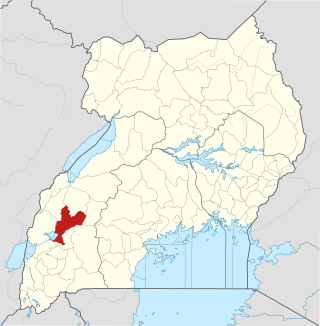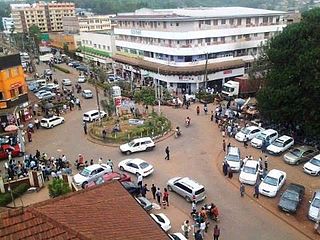
The Kipsigis or Kipsigiis are a Nilotic group contingent of the Kalenjin ethnic group and speak a dialect of the Kalenjin language identified by their community eponym, Kipsigis. It is observed that the Kipsigis and another aboriginal group native to Kenya known as Ogiek have a merged identity. The Kipsigis are the biggest of the Kalenjin. The latest census population in Kenya put the Kipsigis at 1,972,000 speakers, accounting for 45% of all Kalenjin speaking people. They occupy the highlands of Kericho stretching from Timboroa to the Mara River in the south and the Mau Escarpment in the east to Kebeneti. They also occupy parts of Laikipia, Kitale, Nakuru, Narok, the Trans Mara District, Eldoret and the Nandi Hills.

The Kalenjin are a group of tribes indigenous to East Africa, residing mainly in what was formerly the Rift Valley Province in Kenya and the Eastern slopes of Mount Elgon in Uganda. They number 6,358,113 individuals per the Kenyan 2019 census and an estimated 273,839 in Uganda according to the 2014 census mainly in Kapchorwa, Kween and Bukwo districts.

The Abagusii are a Bantu ethnic group and nation indigenous to Kisii and Nyamira counties of former Nyanza, as well as parts of Kericho and Bomet counties of the former Rift Valley province of Kenya.

Trans-Nzoia County is a county in the former Rift Valley Province, Kenya, located between the Nzoia River and Mount Elgon, 380 km northwest of Nairobi. At its centre is the town of Kitale which is the capital and largest town. The county borders Bungoma to the west, Uasin Gishu and Kakamega to the south, Elgeyo-Marakwet to the east, West Pokot to the north and the Republic of Uganda to the Northwest. Trans Nzoia covers an area of 2495.5 square kilometres.

Nyeri is a town situated in the Central Highlands of Kenya. It is the county headquarters of Nyeri County. The town was the central administrative headquarters of the country's former Central Province. Following the dissolution of the former provinces by Kenya's new constitution on 26 August 2010, the city is situated about 150 km north of Kenya's capital Nairobi, in the country's densely populated and fertile Central Highlands, lying between the eastern base of the Aberdare (Nyandarua) Range, which forms part of the eastern end of the Great Rift Valley, and the western slopes of Mount Kenya.

Kamwenge District is a district in Western Uganda. It is named after its 'chief town', Kamwenge, where the district headquarters are located. Kamwenge District is part of the Kingdom of Toro, one of the ancient traditional monarchies in Uganda. The kingdom is coterminous with Toro sub-region. The districts that constitute the sub-region are: (a) Bunyangabu District (b) Kabarole District (c) Kamwenge District (d) Kyegegwa District (e) Kitagwenda District and (f) Kyenjojo District.

Nakuru is a city in the Rift Valley region of Kenya. It is the capital of Nakuru County, and is the third largest urban area in Kenya. As of 2019, Nakuru has an urban population of 570,674, making it the largest urban centre in the Rift Valley, succeeding Eldoret, Uasin Gishu County. The city lies along the Nairobi–Nakuru Highway, 160 kilometres (99 mi) from Nairobi.

Kisii is a municipality and urban centre in south-western Kenya and the capital of Kisii County. Kisii Town also serves as a major urban and commercial centre in the Gusii Highlands—Kisii and Nyamira counties—and the South Nyanza region and is the second largest town in formerly greater Nyanza after Kisumu City. Kisii municipality sits right at the centre of the western Kenya tourist circuit that includes the Tabaka Soapstone Carvings, Maasai Mara, Ruma National Park and part of the Lake Victoria Basin.

Kericho is the biggest town in Kericho County located in the highlands west of the Kenyan Rift Valley. Standing on the edge of the Mau Forest, Kericho has a warm and temperate climate making it an ideal location for agriculture and in particular, the large scale cultivation of tea.
Kapsabet is a town in Kenya. It is the capital of Nandi County and is located 40 kilometres southwest of Eldoret on the way to Chavakali.
Litein is a town located in the Kericho County, Kenya. It was previously the capital of the former Buret District. Litein has an urban population of 4,000. The town is along the Kericho-Sotik road. It also has a road link to Bomet.

Bomet is the capital and largest town of Bomet County, Kenya. Bomet town has a total population of 110,963. It is located along the B3 Mai Mahiu-Narok-Kisii road. Bomet city is one of the eight sister cities to Milwaukee.
Londiani is a Kenyan town in the Kericho County. It is 49 km from Kericho, which is about a 50-minute drive. As of 2009, it had a total population of 44,953.
Kerugoya is the biggest town in Kirinyaga County, located 10 kilometres east of Karatina and 40 kilometres west of Embu. It is situated in the former Kirinyaga district. Travel directions by road from Nairobi is through Thika Road past Thika, Kenol and Makuyu. The road leads through Makutano until Sagana town, where a road branches off the East towards Kagio town up to Kirinyaga University branching North towards the town.
The following lists events that happened during 2008 in Kenya.
Kipkalya Kiprono Kones was a Kenyan politician who served as a minister during the 1990s and was briefly Minister of Roads in 2008. He was a member of the National Assembly of Kenya from 1988 to 2008.
Fort Ternan is a small town in Kericho County, Kenya, located 50 kilometres east of Kisumu and five kilometres east of Koru. It is named after Col. Trevor Ternan C.M.G.D.S.O. Fort Ternan is located at the western border of the former Rift Valley Province. Fort Ternan forms a ward of Kipkelion West Constituency and Kipsigis town council. Fort Ternan is also a location in the Chilchila division.
Sondu is a small town border town in Kenya's Kisumu County and Kericho County.The boundary between Kisumu and Kericho counties has been contentious for years with original boundary posed to have been behind Sondu Police station which was in Kisumu County until 1992 when it was taken back to Kericho County. It borders Homabay County to the south with river Sondu-Miriu acting as a boundary to the south. It also acts as a transport hub between Kericho, Kisumu and Kisii towns as the Kisumu-Kisii highway passing through it.
Sotik Constituency is an electoral constituency in Kenya established for the 1997 elections. It is one of five constituencies in Bomet County. Sotik has one major river, River Kipsonoi. Sotik is also a hilly place with the main crops being grown are tea and maize. The Nairobi Kisii highway passes through Sotik. Recently, many developments have occurred; Sotik Market was put up by the former governor Hon Isaac Ruto, since then infrastructure has been improving. Sotik is also a religious center with over 10 churches set up in the area, e.g., Bethel AGC, St Joseph's Sotik catholic church and Gustavo D' Kerich chapel.
The Lumbwa Treaty event took place on 13 October 1889, in Lumbwa in Kericho between the Kipsigis led by Menya Araap Kisiara and the British East Africa administration. It was based on a cultural practice of oath taking in Kipsigis called Mummek or Mummiat or Mumma. Mumma means "to do something impossibly disgusting". It involves two parties taking an oath and invoking a preemptive curse if the oath is to be broken by any party taking the oath. There usually would also be a performance of black magic; and on this particular event a coyote was savored in two halves with each party burying its part and making the oath never to harm each other in any way.












